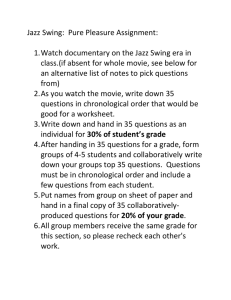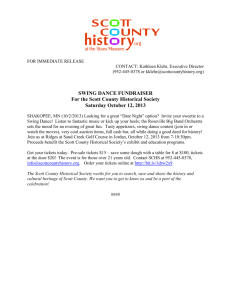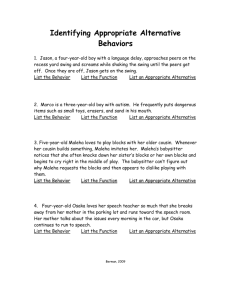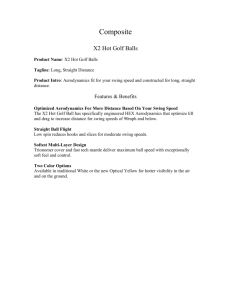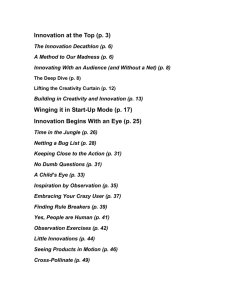A. The swing era, 1935–1945 a. Beginning in 1935, a new style of
advertisement
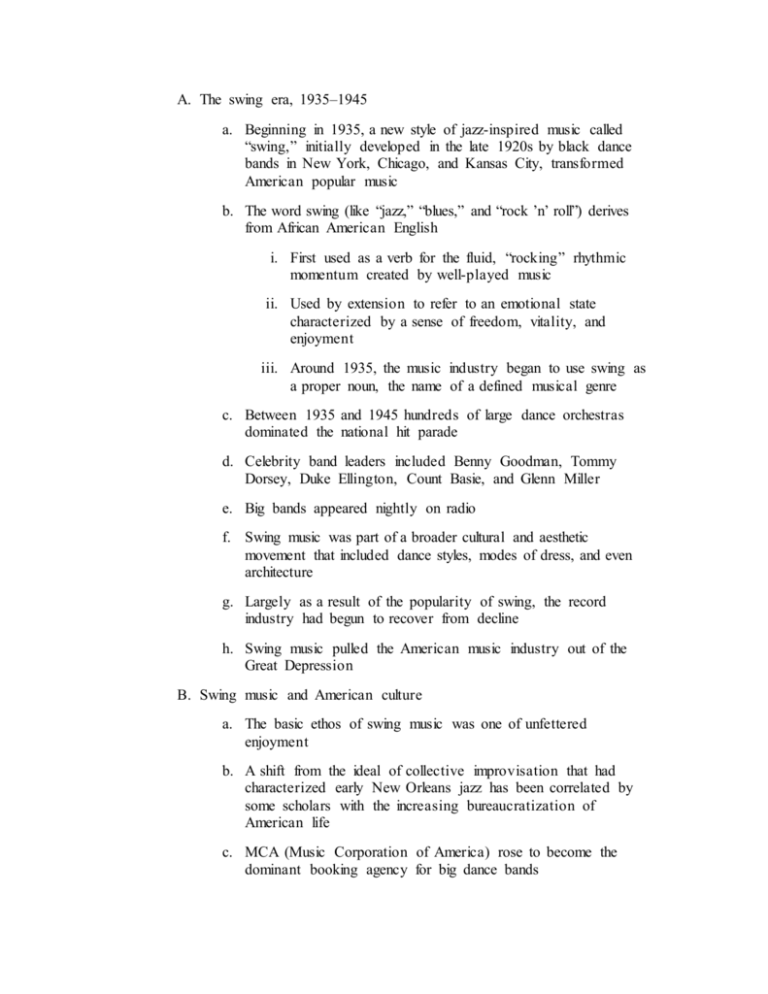
A. The swing era, 1935–1945 a. Beginning in 1935, a new style of jazz-inspired music called ―swing,‖ initially developed in the late 1920s by black dance bands in New York, Chicago, and Kansas City, transformed American popular music b. The word swing (like ―jazz,‖ ―blues,‖ and ―rock ’n’ roll‖) derives from African American English i. First used as a verb for the fluid, ―rocking‖ rhythmic momentum created by well-played music ii. Used by extension to refer to an emotional state characterized by a sense of freedom, vitality, and enjoyment iii. Around 1935, the music industry began to use swing as a proper noun, the name of a defined musical genre c. Between 1935 and 1945 hundreds of large dance orchestras dominated the national hit parade d. Celebrity band leaders included Benny Goodman, Tommy Dorsey, Duke Ellington, Count Basie, and Glenn Miller e. Big bands appeared nightly on radio f. Swing music was part of a broader cultural and aesthetic movement that included dance styles, modes of dress, and even architecture g. Largely as a result of the popularity of swing, the record industry had begun to recover from decline h. Swing music pulled the American music industry out of the Great Depression B. Swing music and American culture a. The basic ethos of swing music was one of unfettered enjoyment b. A shift from the ideal of collective improvisation that had characterized early New Orleans jazz has been correlated by some scholars with the increasing bureaucratization of American life c. MCA (Music Corporation of America) rose to become the dominant booking agency for big dance bands d. During the swing era, network radio was the most important means of promoting popular music e. The 1930s also saw the appearance of radio shows featuring phonograph records rather than live performances f. Some criticisms of swing—with references to sexual deviance, animals, and cannibalism—echo the racist tone of attacks on syncopated dance music during the 1920s g. Big band concerts and dances in big cities during the late 1930s and the war were also racially mixed h. Dance styles that paralleled swing music provide further evidence of the increasing centrality of black styles and sensibilities in American popular culture i. Beginning in the late 1920s, dancers at the Savoy Ballroom in New York City developed the lindy hop i. Smoother, with more fluid horizontal movements than older dance steps ii. Provided greater scope for improvisation iii. Virtuosic element of the lindy gradually became more prominent j. Harlem was the location of famous nightclubs and dance halls, including the Savoy Ballroom, the Cotton Club, and the Apollo Theater i. By the late 1920s Harlem was home to a substantial, well- educated, and relatively prosperous black middle class ii. ―Black and tan‖ nightclubs like the Cotton Club were generally owned and operated by Italian and Jewish mobsters k. During the swing era, black people often attended concerts by white dance bands, and whites began to study and imitate black culture with greater passion and in greater numbers than ever before l. The relationship between blacks and whites was not one of full equality m. Even the most popular of black dance bands faced serious economic and social disadvantages vis-à- vis their white competitors n. Core audience for swing music initially consisted of collegeage adults and teenagers o. The musical and cultural influence of swing continued to be strongly felt in postwar rhythm & blues, country and western music, and rock ’n’ roll C. ―Wrappin’ It Up‖ a. Composed and arranged by Fletcher Henderson b. Recorded by Fletcher Henderson (1898–1952) and His Orchestra in 1934 c. The band is considerably larger than most syncopated dance bands of the 1920s d. The rhythmic feeling is more continuous and flowing i. Bass player plays on all four beats in a measure (―walking‖ the bass) ii. The drummer adds to this effect by playing all four beats with his bass drum pedal (―four on the floor‖) and playing a regular tapping pattern on his largest cymbal iii. In some bands, the guitarist would also play chords on every beat iv. Accents on the offbeats (i.e., a slight push to beats 2 and 4) e. Basic structure is AABC (a thirty- two- bar Tin Pan Alley form) f. Call-and-response relationship between the reeds and brass is established from the first moment g. Soli passages sound like improvised solos that have been written down for multiple instruments D. Benny Goodman: ―The King of Swing‖ a. Goodman was born in Chicago, the son of working-class Eastern European Jewish immigrants b. Career was boosted by John Hammond (1910–1987), an influential jazz enthusiast and promoter c. In 1934 the Goodman band got its first big break on a national radio program called Let’s Dance sponsored by the National Biscuit Company d. Fletcher Henderson’s arrangements became the center of the Goodman band’s collection of charts e. The band went on a grueling cross-country tour of onenighters; when the band arrived at the Palomar Ballroom in Hollywood, fans lined up all the way around the block (considered the birth of the swing era) f. Their popularity had been built up by network radio appearances g. The press crowned Benny Goodman ―the King of Swing‖ h. Goodman was the first prominent white bandleader to hire black players i. Decision to hire black musicians led to the integration of other prominent big bands E. Listening to ―Taking a Chance on Love‖ a. Arranged by Fletcher Henderson b. Reached number one on the hit parade chart published in the influential trade journal Billboard in 1943 c. Henderson makes use of the basic techniques of swing arranging, including call and response between reeds and brass and soli sections with a melody played in harmony d. Popularized in a Broadway musical (and subsequent Hollywood film) called Cabin in the Sky e. Features singer Helen Forrest (1917–1999), who was in her time regarded as one of the greatest of the big band crooners f. Form of the song ―Taking a Chance on Love‖ is the familiar thirtytwo-bar AABA song structure g. The introduction uses a somewhat unusual structure that, reflecting Henderson’s mastery of the art of big band arrangement, sounds completely natural F. Duke Ellington in the swing era a. During the swing era, Duke Ellington continued to develop his unique approach to jazz composition and arranging b. Ellington’s idiosyncratic approach generally meant that his band enjoyed less commercial success than more mainstreamsounding dance orchestras c. By the time the swing era opened in 1935, Duke Ellington had already been leading a band for almost twenty years d. Ellington was not only a skilled instrumentalist and bandleader, but also an innovative composer and arranger G. Listening to ―Caravan‖ a. Song was adapted by Ellington from an improvised melody played at a rehearsal by the Puerto Rican–born valve trombonist Juan Tizol (1900–1984) b. First recorded by a seven-piece group drawn from the Ellington band c. The 1937 recording, the first by the full fifteen-piece band, is unique in its subtlety and freshness d. Begins with the drummer Sonny Greer (1895–1982), who met Ellington in 1919 and had played with him ever since i. In most swing bands, the drummer kept time and drove the band forward with a strong dance-oriented pulse; in the Ellington band, Greer’s contribution was more broadly musical e. ―Caravan‖ is in the thirty- two- bar, AABA form f. Evokes stereotypes of non-Western music and, more generally, ―the Orient‖ g. Evokes the generalized, habanera-inspired ―Spanish tinge‖ h. Features a valve trombone solo by Juan Tizol and growling, wah-wah sounds of trumpeter Cootie Williams i. The title of the tune evokes a lonely caravan snaking through a moonlit Middle Eastern desert H. Kansas City swing: Count Basie a. The band most closely associated with the blues tradition was led by the jazz pianist William ―Count‖ Basie (1904–1984) b. During the 1920s and early 1930s black dance bands in Kansas City had developed their own distinctive approach to playing hot dance music c. The Kansas City style was more closely linked to the country blues tradition than the style of the New York bands, and it relied more heavily upon riffs d. Kansas City bands relied heavily on ―head charts,‖ arrangements that evolved during jam sessions and were written down only later, almost as an afterthought e. Kansas City bands tended to swing more intensely and with greater abandon than the East Coast dance bands f. One important influence on the rhythmic conception of the K. C. bands was the boogie-woogie blues piano tradition g. John Hammond worked to sign Basie on with MCA, secure engagements in Chicago and New York City, and get Basie a recording contract with Decca h. Rhythm section for the band included Basie on piano, Jo Jones on drums, Walter Page on bass, and Freddie Green on guitar I. Listening to ―One O’Clock Jump‖ a. Recorded by Decca in 1937 and was the Count Basie Orchestra’s theme song b. Consists of ten choruses of twelve-bar blues c. Begins with an eight- bar piano boogie- woogie introduction and two improvised twelve-bar blues choruses by Basie d. The final three choruses of riffs are what identify ―One O’Clock Jump‖ for swing fans and musicians alike J. Superstar of swing: Glenn Miller a. From 1939 until 1942 the Glenn Miller (1904–1944) Orchestra was the most popular dance band in the world b. Miller developed a peppy, clean- sounding style that appealed to small- town midwestern people as well as to the big-city, East and West Coast constituency c. In terms of sheer popular success, the Miller band marked the apex of the swing era K. Listening to ―In the Mood‖ a. The Glenn Miller Orchestra’s 1939 recording of ―In the Mood,‖ which held the number one position on the charts for twelve weeks, was the biggest hit record of the swing era b. Alternates the twelve-bar blues form with a bridge phrase reminiscent of Tin Pan Alley songs c. The main riff—that is, the featured saxophone part by which most people remember the recording—had been around for quite a while before Miller got hold of it d. A particularly famous aspect of ―In the Mood‖ is its ―trick‖ ending, with the band getting quieter and quieter and then exploding into a big finish e. ―In the Mood‖ was one of the most commercially successful applications of the blues form in the history of American popular music f. ―In the Mood,‖ like most big hits of the swing era, was escapist in content and outlook L. Listening to ―Paper Doll‖ a. Recorded by the Mills Brothers in 1942, an African American vocal group accompanied by the guitar b. The best-selling record of the swing era except for Bing Crosby’s recording of ―White Christmas‖ c. Their smooth, jazz- influenced style appealed to a broad audience d. ―Paper Doll‖ was the Mills Brothers’ biggest hit e. Success is partly attributable to a recording ban, which barred instrumental musicians from making records for a period during the war f. Expresses the anxieties of a young man who has decided to fashion an inanimate lover to protect himself from the treachery of ―real live girls‖ g. Utilizes a ―double- time feel‖ h. The cheerful, lively approach of the latter part of the arrangement puts the lyrics into an entirely new context M. Country music in the swing era: Roy Acuff, singing cowboys, and western swing a. The appeal of so-called hillbilly performers and their music, based in Anglo- American folk traditions, continued to grow between 1935 and 1945 b. Millions of white southerners migrated in search of industrial employment, forming enclaves in urban centers such as Nashville, Atlanta, Detroit, Chicago, Cincinnati, St. Louis, and Los Angeles c. The appeal of country music also appears to have spread among many people who were not born in the South d. Listeners throughout the country were exposed to country music on the radio e. The formation of BMI provided opportunities for country songwriters to publish their compositions and to receive royalties f. The American Federation of Musicians’ recording ban created more recording opportunities for hillbilly musicians, most of whom were not allowed to join the union g. After the recording ban ended, major companies began to pay more attention to country music, and popular mainstream artists such as Bing Crosby and the Andrews Sisters released bestselling versions of country songs h. Themes of sentimentality, morality, and patriotism, already prominent in hillbilly recordings of the 1920s, played an important role in country music’s popularity during the war N. Roy Acuff a. Roy Claxton Acuff (1903–1992) was the most popular hillbilly singer of the swing era b. In 1938 he joined the regular cast of WSM’s Grand Ole Opry and soon became its biggest star c. Performed in a style that was self- consciously rooted in southern folk music d. His band used instruments derived from the southern string band tradition, including the fiddle, banjo, and guitar O. Listening to ―Great Speckled Bird‖ a. Roy Acuff’s initial rise to fame was in large part a result of the popularity of two songs that are still closely associated with him, ―Wabash Cannonball‖ and ―Great Speckled Bird‖ b. Acuff’s rendition of ―Great Speckled Bird‖ crossed over to the mainstream pop charts, reaching number thirteen on the Billboard Hit Parade in 1938 c. Portrays the church as an embattled group of individuals i. Speckled bird is a metaphor for the church, a sign of God’s Word (as inscribed in the Bible), and a vehicle for the salvation of the faithful d. Traditional ethos reinforced by Acuff’s straightforward, unadorned vocal performance and the strophic form of the song e. Features a new version of the standard six-string guitar called the Dobro, which used a round metal plate (a resonator) to amplify the sound of the strings f. On this recording the blunt edge of a steel knife is used to play melodic patterns on the Dobro, allowing the player to glide between pitches P. Singing cowboys a. The heroic image of the old cowhand was adopted by many country musicians during the depression years as a substitute for the often-denigrated image of the hillbilly b. In popular culture, the West is associated with movement, independence, and the future c. From the 1930s through the 1950s the term ―western‖ became a substitute for ―hillbilly‖ d. Many country singers, whatever their place of birth, wore cowboy hats and shirts and adopted nicknames such as ―Tex,‖ ―Slim,‖ ―Hank,‖ or ―the Lone Cowboy‖ Q. Gene Autry (1907–1998) a. The first successful singing cowboy b. In a series of over ninety movies for various film companies Autry institutionalized the image of the singing cowboy, a heroic figure as adept with his voice and six strings as with a six-shooter c. Autry developed a style designed to reach out to a broader audience, with a less pronounced regional accent, a deep baritone voice, and a touch of the crooner’s smoothness d. Paved the way for other western recording artists, including Roy Rogers, Patsy Montana, Tex Ritter, and the Sons of the Pioneers e. Helped to bring country music to a much wider and more diverse audience R. Sons of the Pioneers a. Originally formed as a vocal trio in 1933 by Len Slye (1911– 1998), who later left the group and became a film and television star under the name Roy Rogers b. Sang in many cowboy movies and represented the cosmopolitan end of western music c. Specialized in sophisticated vocal harmonies d. Member Bob Nolan wrote ―Tumbling Tumbleweeds,‖ ―At the Rainbow’s End,‖ and ―Cool Water‖ S. Listening to ―Cool Water‖ a. Recorded in 1941 b. Features the vocal trio’s smooth, carefully rehearsed harmonies and the lead singing of Bob Nolan c. Opens with the guitar and fiddle, playing the basic ―hook‖ of the song (“cool, clear water”) d. The impact of the song’s lyric lies in its use of the first-person voice and in its verbal imagery, which impressionistically conveys the singer’s experience e. Imagery is derived from Hollywood films T. Western swing a. Concatenation of country fiddle music, blues, boogie-woogie, and swing music b. Reflects Texas’s diverse musical traditions, including cowboy songs, German and Czech polkas, and Texas–Mexican (Tejano) genres such as corridos (narrative ballads in Spanish), conjunto acordeon (―accordion band‖ music), and mariachi (―marriage‖) music c. Played by ensembles consisting of violins, guitars, and two or more trumpets U. Bob Wills (1905–1975) a. Seminal figure in the national popularization of western swing b. Formed the Texas Playboys in 1934 i. The band established itself in Tulsa, Oklahoma, making daily radio appearances, playing nightly in a local ballroom, and going on tours of the ―southwest territories‖ c. In 1943, after being discharged from the army, Bob Wills relocated to California d. The Texas Playboys’ style became so popular in California that even mainstream swing bands were asked by dancers to add western swing–style numbers to their repertoires e. The heart of the Texas Playboys’ style was southern string band music f. Wills added elements from big band swing, including call-andresponse riffs, and instruments such as trumpets, saxophones, and the drum set g. During the Texas Playboys’ performances Bob Wills acted as impresario, cracking jokes, calling out musicians’ nicknames, and giving out enthusiastic cries and whoops of encouragement h. Exerted a permanent influence on country music i. Introduction of amplified steel guitar and drum set ii. Incorporation of African American and Latin American musical influences iii. Emphasis placed in live performances on improvised instrumental solos V. Listening to ―New San Antonio Rose‖ a. Biggest hit for Bob Wills and the Texas Playboys b. Structure of the song is the AABA thirty-two-bar form c. Sixteen- piece ensemble combines a string band and a big band d. Tommy Duncan’s singing is supported with soft harmonies in the brass and reeds and occasionally interrupted by Wills’s trademark vocal interjections W. Latin music in the swing era a. During the 1930s and 1940s an ever greater number of Latin American musicians immigrated to New York City, Los Angeles, and other American cities b. Black bandleaders such as Chick Webb and Cab Calloway were among the first to hire Latin American musicians c. Although the Cuban stream was dominant, other Latin and Caribbean traditions also influenced the pop mainstream during the swing era d. Mexican genres such as mariachi music and corrido ballads influenced country and western music e. Brazilian music reached the United States in the mid-1930s via popular Hollywood films i. Examples include the carioca, a ballroom version of the samba f. Swing numbers larded with a few south-of-the- border musical stereotypes played an important role in filtering Latin influences into mainstream popular music X. Xavier Cugat (1900–1990), a.k.a. the ―Rhumba King‖ a. The bandleader who did the most to popularize Latin music during the swing era b. During the height of the tango craze, he migrated to New York and began working as a musician c. Around 1920 Cugat moved to Los Angeles, where he was employed as a cartoonist and appeared in several movies d. In 1932 Cugat returned to New York and began a three-decade stint at the Waldorf-Astoria Hotel e. His band was a training ground for Latin music stars, including Desi Arnaz of I Love Lucy fame Y. Listening to ―Brazil‖ a. Written by Ary Barroso, performed by Xavier Cugat and his Waldorf- Astoria Orchestra; recorded 1943 b. Xavier Cugat’s best-selling record c. Introduced a new genre to Brazilian popular music—the sambaexaltação, a samba exulting in the beauties of the land d. One of the most-recorded songs of all time e. Opens with a rhythmically free treatment of the song’s opening phrase by the Mexican American vaudevillian and singer La Chata f. The rhythm section establishes a flowing samba rhythm, played on pandeiro (large tambourine), tamborim (small tambourine), and Cuban maraca g. The musical logic of ―Brazil‖ is centered on two elements: first, a one-measure syncopated pattern, repeated over and over to create momentum, and second, a sweeping, almost cinematic melody with an ABCD form h. Throughout the arrangement the rhythmic pattern and the melody are tossed from instrument to instrument, and extra measures are introduced at important transition points i. The samba pattern generates a feeling of groove through repetition j. Juxtaposes the logic of European song composition and the vitality of Afro-Brazilian music k. The reception of Latin American music in the United States was filtered through existing stereotypes of tropical romance and passion, bolstered by Hollywood films and the tourist trade Z. Mario Bauza (1911–1993) a. The musician who did the most to introduce authentic AfroCuban music into big band jazz b. Composer, arranger, clarinetist, and trumpeter often called the ―Father of Latin Jazz‖ c. Worked with bandleaders Chick Webb and Cab Calloway and trumpeter John Birks (―Dizzy‖) Gillespie (1917–1993) d. Arranged for his brother- in- law, the Havana-born bandleader and singer Frank Grillo, a.k.a. Machito (1909–1984), to join him in New York e. Directed the Afro-Cubans featuring musicians familiar with the phrasing and rhythmic feel of jazz and also able to understand and perform the complex interlocking rhythms of Afro-Cuban music f. Used the full battery of percussion instruments that formed the core of Cuban dance music: maracas, bongó, conga, and timbales AA. Listening to ―Nagüe‖ a. Written by Luciano (Chano) Pozo; arranged by Mario Bauza and John Bartee; performed by Machito and his Afro-Cubans; recorded 1941 b. Did not dent the pop charts c. Gives a good sense of the intensity and drive of the rumbabased percussion music that would eventually become the mainstream of the family of Latin music styles known as salsa d. The African-derived term ―Nagüe‖ is Cuban slang for ―bud(dy)‖ or ―bro(ther)‖ e. Brief lyrics recount in dialog form a verbal exchange between two tough- guy characters on a street in one of Havana’s barrios f. Signaled to knowledgeable listeners a deeper, grittier, more authentic engagement with Caribbean culture g. Elaborated version of a two-part structure long in use by Havana dance bands i. An initial, formally arranged statement of the song ii. Followed by an improvisational section anchored in African-derived call-and- response patterns and a repeating melodic-rhythmic loop, the montuno h. ―Nagüe‖ opens with complex harmonies of the sort increasingly favored by the more progressive swing arrangers i. The montuno section opens with a soaring vocal improvisation over the repeated coro, setting up a call-and-response texture j. Then the percussion takes over for twelve increasingly intense measures, with Bilingüe Ayala playing a rhythmically complex bongó solo over the interlocking patterns k. The sense of a direct connection to African-derived tradition in the montuno section of ―Nagüe‖ is intensified by the vocalist’s inside references to aspects of life in Cuba i. Includes references to Abakwá, an Afro-Cuban men’s secret society that originated from fraternal associations in Nigeria and Cameroon BB. ASCAP, the AFM, and the decline of the big bands a. By the close of 1946 many of the top dance bands in the country had either broken up or formed smaller, more economical units b. Some swing bandleaders had joined the armed forces and a number of well- known musicians were killed in the war, including Glenn Miller c. The music business was affected by shortages in gas and vehicles, material shortages, and social policies including a 20 percent entertainment tax and midnight curfew d. The big bands were adversely affected by a series of struggles among powerful institutions in the music business e. In 1941 ASCAP called a strike, withdrawing the rights to broadcast any material composed by their members, which took away a lion’s share of the big band repertoire f. On August 2, 1942, the musicians’ union called a strike against the recording companies claiming musicians were not being properly compensated for their performances i. James Caesar Petrillo, president of the AFM, wanted the recording companies to pay musicians a share of royalties when records were played on radio broadcasts and coin-operated jukeboxes CC. The swing era a. Represented the peak of jazz’s influence on popular music b. After World War II many jazz musicians moved in other directions, less concerned with record sales i. Exemplified by a new jazz idiom called bebop, pioneered principally by the great alto saxophonist Charlie Parker (1920–1955) and trumpeter Dizzy Gillespie c. The singers who had appeared with big bands became even bigger celebrities in their own right, overshadowing bandleaders who had formerly enjoyed the spotlight d. Another branch of swing music, performed by small groups and christened ―rhythm & blues‖ by the record industry, maintained its function as social dance music

